Postcards from Tuscany

This week’s travel piece is another postcard. It’s from a guest blogger who’s posted on these pages before–Emily Gold from Paper Cake Scissors. Here’s her postcard from Tuscany loaded with winding roads, rolling hills, rich history, and of course plenty of pasta and vino!
Gustare!
![]()
Italy was never at the top of my travel wish list until my mom told me that she and my dad were considering a visit over the holidays. The conversation with my husband over whether or not to go was brief, leading to a quick call back to my parents to say YES. I didn’t regret our decision for a minute, especially when, two hours after landing in Rome, we were already exploring the Pantheon. We focused on Tuscany except for one hop across the border into the Umbrian city of Perugia and a brief cruise through Rome during a five-hour layover on the way to Florence. And yes, my parents and husband and I all got along, and we had a very memorable holiday captured in hundreds and hundreds of pictures.
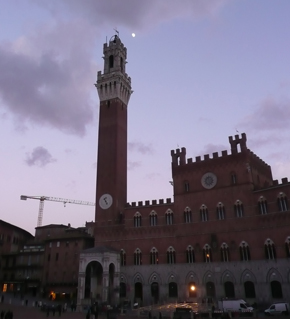
Siena is an entirely walled city that dates from the Middle Ages.
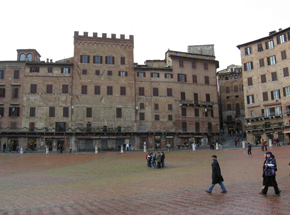
It owes its remarkable intact-ness to the Black Death; Siena’s population was decimated by the plague, so very little about the town changed over the years.
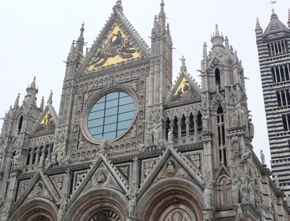
Siena’s Duomo is an impressive structure, decorated as ornately as a Victorian wedding cake. I couldn’t stop looking at the floors, even though I felt that somehow, the artists thought it wasn’t enough that every square inch of the ceiling and walls was adorned.
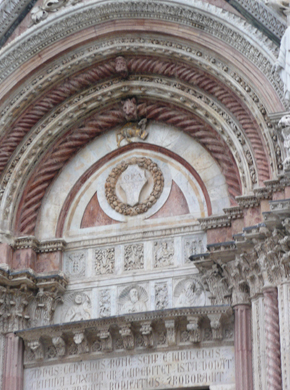
Only a portion of the floor is revealed year-round. The most intricate sections are covered by cardboard for much of the year, only to be revealed at the end of August for several weeks.
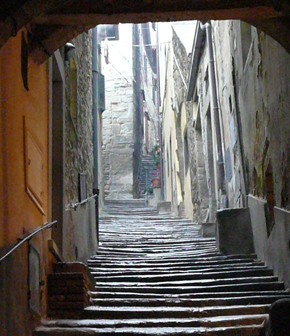
The town was almost spooky at night with mazes of tiny winding alleyways and huge stone steps that crossed beneath the massive timbers of the structures. We ate dinner in a restaurant where the small rooms descended into a dark cave.
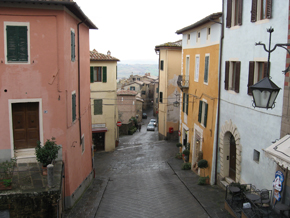
Every tiny Tuscan town is as beautiful as the last. We’d wind up the narrow roads among the rows of barren grapevines and lively march of gray-leaved olive trees. At the top, we’d park and climb a maze of narrow cobbled streets that meandered up to a main piazza and church where tunnel-like alleys dropped away, revealing slivers of the landscape.
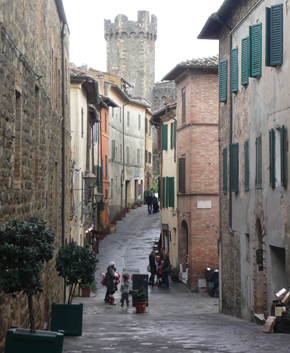
It might be a toss up as to whether I liked Cortona or Montalcino better. Both are very sweet southern Tuscan hill towns with equally charming characteristics. The unique clock tower in Cortona towers over an intimate little piazza. Narrow streets lead out from the piazza with stores full of leather goods, fine stationary and books, and pastries lining both sides. And it’s where Under the Tuscan Sun author Frances Mayes resides for part of the year. Montalcino, besides being an important source for red wine, is also incredibly charming. We had a delightful lunch of handmade pasta; pinci, a fat, traditional pasta of Tuscany, for my parents and husband, and ravioli for me.
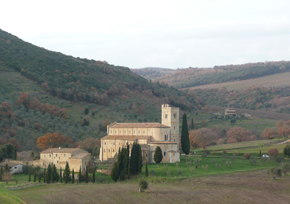
Just outside of Montalcino, at the foot of the hill, is a Benedictine abbey, Sant’ Antimo. Something about the way the sunlight struck the creamy marble and its location in the countryside, surrounded by personable cedars and olive trees, was truly magical. Monks live in the commune next to the abbey and still worship at the abbey numerous times a day. Unfortunately, we missed their services, but a recording of their Georgian chants gave you a sense of how soulful it would be. The interior is plain compared to many of the other churches, but elegant in its simplicity and the way it reflected and absorbed the sunlight. Also notable was the temperature, which was freezing; the smooth white walls were blocks of ice.
My first visit to Italy left me thinking about my return. What other towns and regions would I want to visit next time? Where would I want to visit again? And it left me with a renewed interest to learn the language so I can experience authentic Italian life when I come back.








